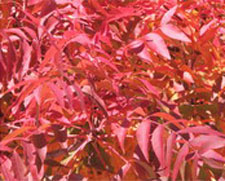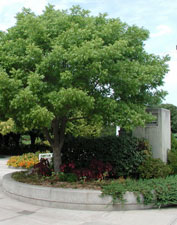Resource Library
Plant of the Week: Pistache, Chinese
The University of Arkansas System Division of Agriculture does not promote, support or recommend plants featured in "Plant of the Week." Please consult your local Extension office for plants suitable for your region.
Plant of the Week
Chinese Pistache
Latin: Pistacia chinensis

showy flowers are produced in the spring before the foliage appears. Female trees produce terminal panicles loaded with pea-sized fruit that the birds find as soon as they ripen. The fruit are most commonly seen as red, but these formed without benefit of pollination. Pollinated fruit with viable seeds are blue. Female trees have a less handsome form than their male counterparts.
Chinese pistache is the most cold hardy of the nine species of Pistache which range from North Africa across the Middle East to Central China and a few in this country. The pistachio of commerce (P. vera) is only winter hardy to 15 degrees F and requires a dry climate, so not surprisingly it has found a home in California where it is grown commercially.
The first commercial California pistachio harvest was in 1976, just three years before hostage crisis in Iran soured relations with that nation, which is the leading pistachio producer.
Today, California is the second-largest pistachio producer in the world and services all of the domestic demand. The familiar green pistachio is an artificial dye applied to the fruit, apparently a marketing ploy to differentiate the domestic crop from the smaller, red dyed Iranian nuts. The name for the species traces back through Latin to an original Persian name for the tree.

The other pistache species also produce edible seeds but are too tiny to mess with eating. The green leafy shoots of Chinese pistache were reported to be eaten as a steamed vegetable by E. H. Wilson who introduced the tree to the Arnold Arboretum in 1908. Previously, it had been introduced to England as early as the 1830s and the U.S by 1890.
Chinese pistache is an easily transplanted tree that is most commonly offered as a container-grown specimen. It's winter hardy in zones 6 through 9 and is at its best in hot, dry areas. In low rainfall areas of western Oklahoma and Kansas receiving only 20 inches a year, the tree thrives without irrigation. In the southeastern states, it has gained a following amongst landscape designers because of its tolerance to heat and humidity.
Though it's drought tolerant, it shouldn't be planted in an area with poor drainage and winter-wet soils. It tolerates a wide range of soil pH from 5.5 to 7.5. It's essentially unbothered by insects or foliage disease, though wilt disease can occur in moist areas.
Unfortunately Chinese pistache is difficult to propagate by cuttings or grafting, so most of the time it's offered as seed grown trees. Male plants have better form, so if the sex can be determined before planting, they should be selected. ‘Keith Davey' is a male selection occasionally offered in the nursery trade.
By: Gerald Klingaman, retired
Extension Horticulturist - Ornamentals
Extension News - November 30, 2007
The University of Arkansas System Division of Agriculture does not maintain lists of retail outlets where these plants can be purchased. Please check your local nursery or other retail outlets to ask about the availability of these plants for your growing area.